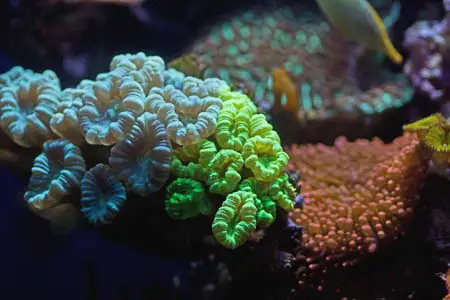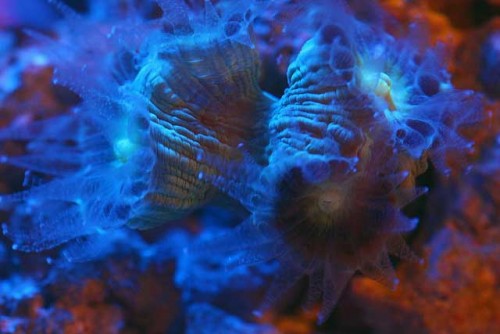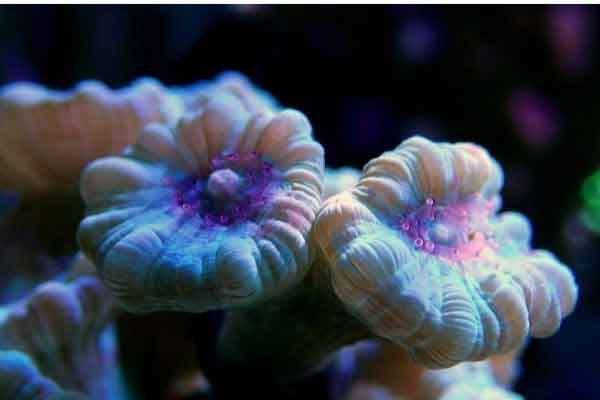The candy cane coral is an LPS coral (stands for large polyp stony coral) species that is great for beginner and intermediate reef tanks. While some LPS corals are aggressive and have large, stinging sweeper tentacles, this attractive coral species is mild-mannered and has very short sweeper tentacles, by comparison, and can, therefore, be kept relatively closer to other peaceful coral species without causing any problems.
A healthy candy cane coral colony (say that tongue-twister 5 times in a row) will create additional branches as it grows.

They are considered to be large polyp stony corals. The bases of the branches are hard (stony) largely composed of calcium carbonate and the tops have large, fleshy Candy-cane striped polyps. The soft flesh contains symbiotic zooxanthellae and also feeding polyps that will capture prey.
Table of contents
This article has the following content. Each of these is a link that will take you to the corresponding part of the page if you want to jump ahead.
- Quick facts
- Candy cane coral care
- Alternate names
- How they get their stripes
- Troubleshooting
- How to frag
- Where to go next
Quick facts
- Scientific Name: Caulastrea furcata
- Common Names: Candy cane coral, Trumpet coral
- Natural location: Generally sheltered, shallow-water, sandy substrate (Borneman 2001)
- Suitable Tank Size: Nano to large reef would be appropriate
- Aggression Level: Peaceful
- Compatibility: Extremely compatible with other Euphyllia species (torch, frogspawn, etc.)
- Care Level: Easy
- Lighting: Low-to-moderate
- Flow: Low-to-moderate
- Feeding recommended: yes, target feeding of small, meaty zoo-plankton-like foods when feeding polyps are extended
- Calcium supplementation: yes, maintain calcium > 400 ppm
Candy Cane Coral Care
The Candy Cane coral is a hardy, relatively easy coral to care for. They prefer low-to-moderate water flow as well as low-to-moderate light intensity, and tend to grow best, like most coral species, when routinely fed. A bit more about that soon.
Candy Cane coral placement
The best placement for a candy cane coral is in a location that gets low-to-moderate water flow and low-to-moderate intensity lighting. Intense light or flow could cause bleaching or tissue damage.
This LPS coral generally does best when placed lower down in the aquarium, placed on the sandy substrate, if you have one. They require medium lighting or lower, so they are best placed outside of the white-hot intense lighting, on the outer rim of the lighting. The placement, and relative lighting in the tank at that spot, should also not dramatically impact their coloration like it does with some other stony corals.
One final thing to keep in mind is that you don’t want to be constantly moving your corals around. The advice given here about gradually moving your coral to the perfect location is intended to apply when first introducing the coral to your system. It is typically best to let a “happy” coral be. Moving them around too much can create additional stress.
Feeding
They do get some of the food and energy they need from the light because they have symbiotic zooxanthellate, but like most LPS corals, the candy cane coral also should be fed a few times a week with small particles of a meaty saltwater fish or coral food. Feeding this coral is the right way to care for it and will help accelerate growth.
The challenge with feeding LPS corals like the candy cane is getting enough food to the coral if you have boisterous fish like clownfish or tangs (at least that’s how it goes in my tank, where the fish routinely steal foods from the corals). If you don’t see the feeding tentacles extended, it is worth checking out the tank, after dark, to see if the coral opens up then, or if the tentacles can be coaxed out by feeding. If you literally never see the feeding tentacles, this may be a sign of stress.

Preferred water parameters
The standard water parameter needs apply to caring for this species as well. That means:
- Temperature: 73-84 Fahrenheit, +/- a degree or two
- pH: ~8.1-8.4
- Hardness: 8-12 dkH
- Specific gravity: 1.025
- Ammonia, nitrites, nitrates: 0 ppm
- Calcium: 400 ppm
Check out this article for more information about the most important reef aquarium water parameters. Calcium is an important nutrient for this coral species since it is a main component of the calcium carbonate skeleton. Insufficient pH, hardness, and calcium may spell trouble for this coral long term.
Alternate names
At your local fish store, you may find the Candy cane coral sold under one of these other names: trumpet coral, bullseye, or even, very confusingly torch coral. That’s the problem with common names. One man’s torch is another man’s candy cane. I’m not even sure why I wrote that.
How they get their stripes
Coloration in corals can be a bit tricky to nail down. You see the coral at your local fish store under the actinic lights and think…this thing is going to look awesome in my tank…only to find out later that it looks nothing like that in your own tank. Well, the reason for that is that coral coloration is very much dependent on the lighting above the tank. To maintain the namesake candy cane stripes on your Candy cane coral colony, you will need to keep it happy and healthy.
If you notice your candy cane coral is losing its stripes, that may be a sign that your water parameters are unhealthy or that the coral is getting insufficient light (Borneman 2001).

Troubleshooting
Figuring out exactly what the problem is with your Candy Cane coral care and what is causing your coral stress is part art, part science, and unfortunately is also sometimes a mystery. My advice is to start with what is known about the most recent conditions the animal was in, what is known about the preferred conditions, and what we can be known about the current conditions in your aquarium–and work backward to rule some things out.
Turning white – a symptom of stress, potentially from too much light
A common sign of stress is when the previously colorful, large, fleshy polyps start to lose their color and turn white. If you follow the advice in the previous section, you want to look for and rule out any obvious stressors (change in water quality, stress from shipping, change in temperature, etc.). Turning white can also be a sign that the lighting is too intense. Dimming LED lights or moving the coral down or further out from the center radius of the source of illumination may help.
Dying
Hopefully, you will not experience this, but there are two typical ways you might see your coral die. In way #1, the soft, fleshy tissue starts to shrink (not inflated), then recedes, ultimately exposing more-and-more skeleton at the top. That’s sort of a slower sign of impending disaster.
However, it is also possible to get a brown jelly or similar infection (sometimes linked to a cut or tear in the soft, fleshy polyp section). That is a rapid, almost immediate decline where the coral polyps turn to mush and dissolve into the water, looking almost like (foul-smelling) smoke.
As mentioned at the top of the troubleshooting section, figuring out what caused the problem is a bit like solving a mystery, by reviewing the notes in your Reef Journal, testing the water, checking the parameters, and ruling things out. High nutrients, physical damage from handling, infections and/or starvation, and stress are potential culprits.
How to frag

A Candy Cane coral colony is also an excellent coral for learning how to frag corals. Since the large fleshy polyps of the candy cane coral sit on top of a long, thin, branched coral skeleton, it is fairly straightforward to propagate this coral species by snapping one of the branches.
The individual branches are a marvel–in that this living animal created a stone-like skeleton. At the same time, my experience with branching LPS corals is that the individual branches are also lightweight and brittle and can be fragged relatively easily with coral or bone cutters, which are a specialized tool that looks like large stainless steel wire cutters, or a Dremel-type rotary tool.
Where to go next
My favorite analog, dead tree book about corals is the book Aquarium Corals, by Eric Borneman. Although some of this book reads a bit like a textbook, I find it to be a valuable, comprehensive source of information about aquarium corals.
Check out this video with care tips:
Other articles of interest
You may also find some of these other coral care articles interesting and useful:
Learn about these other great LPS corals:
Dive into the world of SPS corals with the Birdsnest coral.
Or start with a list of saltwater fish to add to your tank to keep in your reef aquarium.
References:
Here are a few references that were used to support some of the information in this article. For more books like this, check out this article.
Borneman, Eric H. Aquarium Corals. Microcosm Ltd; 1st Printing Edition (March 1, 2001)
Ulrich III, Albert B. How to Frag Corals: Step-by-step guide to coral propagation and filling your frag tank with thriving polyps.www.SaltwaterAquariumBlog.com (January 20, 2015).
Ulrich III, Albert B. The New Saltwater Aquarium Guide.www.SaltwaterAquariumBlog.com (April 8, 2014)


Leave a Reply